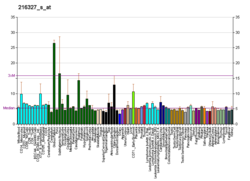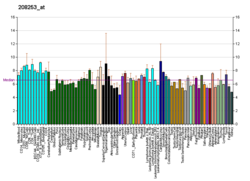Eosinophils
Consistent with the role of most siglecs and the presence of the intracellular ITIM, Siglec-8 has been found to function as an inhibitory immunoregulatory receptor. Ligation of Siglec-8 induces cell death in eosinophils, and, surprisingly, the normally pro-survival cytokines interleukin (IL)-5 and GM-CSF have been found to potentiate this cell death effect. [22] IL-33, which activates and maintains eosinophils, also exerts a similar potentiating effect on Siglec-8-induced cell death. [23] [24] [25] Inhibitor studies demonstrate that cell death induced by crosslinking Siglec-8 through the use of an anti-Siglec-8 mAb and a secondary antibody is mediated sequentially through reactive oxygen species (ROS) production, loss of mitochondrial membrane potential, and caspase activation. [26] In the presence of IL-5, the loss of mitochondrial membrane integrity is accelerated and the secondary crosslinking antibody is no longer necessary to induce cell death. [27] IL-5 stimulation also appears to alter the mode of cell death of eosinophils induced by Siglec-8 ligation in that cell death becomes a caspase-independent process. On IL-5-primed eosinophils, antibody ligation of Siglec-8 was found to lead to CD11b/CD18 integrin upregulation, conformational activation, and subsequent integrin-mediated adhesion. [28] Disruption of integrin-mediated adhesion with antibodies to CD18 prevented Siglec-8-induced ROS production and cell death, indicating that β2 integrins act as essential mediators in the Siglec-8 ligation-induced cell death process in eosinophils. [28] The signaling cascade leading to CD11b/CD18 integrin upregulation and conformational activation was elucidated using pharmacologic inhibition of key signaling molecules combined with analyses of cellular events leading to cell death. [29] This signaling pathway is atypical for an ITIM-bearing siglec and involves the activities of a Src family kinase, Syk, PI3K, phospholipase C, protein kinase C, Rac1, PAK1, MEK1, and ERK1/2. [29] The conformational activation of CD11b was dependent on the activity of Bruton's tyrosine kinase. There was no evidence supporting the involvement of protein tyrosine phosphatases typically associated with ITIM-mediated signaling pathways, such as SHP-1/2, in this pathway. [29]
Disruption of Siglec-8 binding to α2,3-sialylated cis ligands enables Siglec-8 engagement-induced cell death in eosinophils and overcomes the need for cytokine priming (e.g. , with IL-5, GM-CSF, or IL-33) or extensive receptor cross-linking. [21] The cell death pathway licensed by enzymatic removal of these sialylated cis ligands resembles that described in eosinophils primed with IL-5 in that it involves cell-surface upregulation of CD11b and ROS production and requires the activities of Syk, PI3K, and phospholipase C.
Concurrent stimulation of the IL-5 receptor and Siglec-8 leads to a type of cell death resembling regulated necrosis that is promoted by MEK1/ERK signaling. [30] In this experimental system, inhibition of MEK1 does not alter ROS generation but the ROS inhibitor diphenyleneiodonium inhibits ERK1/2 phosphorylation and cell death, leading to the conclusion that the production of ROS is upstream of MEK1/ERK signaling in this pathway. [30] However, in eosinophils that had been primed with IL-5 18–24 h prior to Siglec-8 ligation, the activities of MEK1 and ERK1/2 are necessary prior to integrin upregulation and ROS production. [29] Cell death induced by Siglec-8 in the presence of IL-33, in contrast, is mediated primarily by a caspase-dependent pathway, and IL-33 is capable of synergizing with IL-5 in potentiating cell death induced by Siglec-8 ligation. [24]
Siglec-8 undergoes endocytosis upon antibody ligation on eosinophils and mast cells. [20] This process is dependent on the cytoplasmic ITIM (and not the ITSM), the activities of tyrosine kinases and protein kinase C, and actin rearrangement. Furthermore, it can be exploited to deliver toxins to human eosinophils or mast cells to selectively induce cell death when Siglec-8 ligation by itself would not be sufficient to do so (e.g., on mast cells or unprimed eosinophils). [20]
Mast cells and basophils
Siglec-8 antibody engagement has been shown to inhibit FcεRIα-mediated Ca2+ flux and release of prostaglandin D2 and histamine. [31] In experiments using the rat basophilic leukemia cell line RBL-2H3 stably transfected with Siglec-8, the inhibitory effect of Siglec-8 ligation on FcεRIα-mediated degranulation and Ca2+ flux was found to be dependent on the intact ITIM. [31] In studies involving transgenic mouse Siglec-8-expressing bone marrow-derived mast cells, co-engagement of Siglec-8 and FcεRIα leads to the inhibition of proximal kinase signaling downstream of FcεRI ligation. [32] However, the inhibitory activity of Siglec-8 extends beyond counteracting FcεRI-mediated mast cell activation in transgenic mice: monoclonal antibody engagement of Siglec-8 reduced mast cell activation, immune cell recruitment, and lung fibrosis in a cigarette smoke-induced model of chronic obstructive pulmonary disease and in a bleomycin-induced model of lung injury. [33] Antibody engagement of Siglec-8 also impeded IL-33-driven mast cell activation and immune cell recruitment. Unlike on eosinophils, antibody engagement of Siglec-8 on human mast cells does not lead to substantial levels of cell death. However, enzymatic removal of α2,3-linked sialic acid from the cell surface promotes cell death upon Siglec-8 antibody ligation on primary human mast cells, suggesting that this pathway remains intact in mast cells but that it is restrained by the interaction of Siglec-8 with cis ligands. [21]
There are no published data regarding the function of Siglec-8 on basophils.






